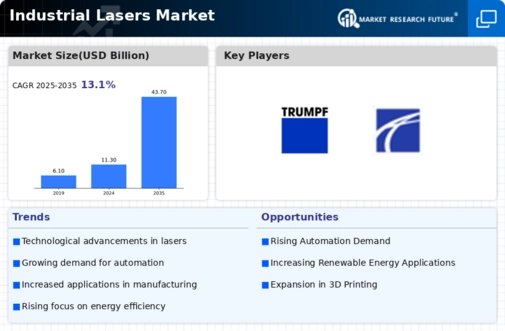Top Industry Leaders in the Industrial Lasers Market

*Disclaimer: List of key companies in no particular order
Top listed global companies in the Industrial Lasers industry are:
Amonics Ltd.
Apollo Instruments Inc.
TRUMPF
Toptica Photonics AG.
Quantel Group
Jenoptik Laser GmbH
IPG Photonics Corporation
CY Laser SRL
NKT Photonics A/S
Coherent Inc.
Bridging the Gap by Exploring the Competitive Landscape of the Industrial Lasers Top Players
The industrial lasers market is currently experiencing a dynamic and evolving competitive landscape. Several key players dominate the market, each adopting distinct strategies to gain an edge. Analyzing their approaches and understanding the factors influencing market share can offer valuable insights into the future of this burgeoning sector.
Key Players and Strategies:
- Established Giants: Companies like Trumpf, IPG Photonics, Bystronic, and Coherent hold significant market share thanks to their extensive product portfolios, global reach, and established distribution networks. These players primarily focus on organic growth through continuous R&D, product diversification, and strategic acquisitions. For instance, Trumpf's recent acquisition of Chinese laser manufacturer Yongxin Lasers reinforces its presence in the Asia-Pacific region.
- Rising Challengers: Emerging players like Han's Laser, Maxphotonics, and Raycus Laser are rapidly gaining traction by offering cost-effective and innovative laser solutions, particularly in fiber lasers. These companies often target specific application segments or regions, aiming to carve out a niche in the market. For example, Han's Laser focuses on the burgeoning photovoltaic industry, while Maxphotonics targets the rapidly growing Chinese market.
- Regional Specialization: Some companies, like Amada and Mazak, excel in specific geographic regions. Amada, for instance, boasts a strong presence in Japan and Southeast Asia, while Mazak caters primarily to the North American market. This regional specialization leverages localized expertise and understanding of market nuances to secure a competitive advantage.
Factors for Market Share Analysis:
- Product Portfolio: The breadth and depth of a company's laser offerings are crucial. Players with diverse portfolios catering to various applications and industries hold an edge. Additionally, providing customized solutions can further enhance market share.
- Technological Innovation: Constant advancements in laser technology, such as increased power, improved efficiency, and miniaturization, drive market growth. Companies at the forefront of innovation attract early adopters and secure future-proof positions.
- Cost Competitiveness: Price sensitivity is high in the industrial lasers market. Offering cost-effective solutions without compromising quality is essential for gaining market share, particularly in emerging economies.
- Brand Reputation and Customer Support: A strong brand identity and reliable customer support build trust and loyalty, leading to repeat business and positive word-of-mouth referrals.
New and Emerging Trends:
- Rise of Fiber Lasers: Fiber lasers are rapidly replacing traditional lasers due to their higher efficiency, compact size, and lower maintenance requirements. Companies investing in fiber laser technology and developing next-generation applications stand to benefit significantly.
- Integration with Automation and AI: The increasing adoption of automation and artificial intelligence in manufacturing processes is driving the demand for laser systems that can seamlessly integrate with these technologies. Companies offering plug-and-play solutions and software interfaces will gain a competitive edge.
- Focus on Sustainability: Growing environmental concerns are increasing demand for green manufacturing practices. Laser systems offering high processing speeds, minimal waste generation, and low energy consumption are becoming increasingly attractive.
Overall Competitive Scenario:
The industrial lasers market is characterized by intense competition, with established players facing pressure from both smaller, agile challengers and new entrants. Technological advancements, regional dynamics, and cost-effectiveness are key factors influencing market share. To thrive in this evolving landscape, companies must adopt innovative strategies, continuously invest in R&D, and cater to specific market segments with laser solutions that are both technologically advanced and cost-competitive. The ability to integrate with automation and AI, prioritize sustainability, and offer strong customer support will further distinguish successful players in the years to come.
Latest Company Updates:
Amonics Ltd.
- Date: October 26, 2023
- Development: Announced collaboration with Fraunhofer IOF to develop advanced high-power fiber lasers for micro-drilling and cutting applications.
Apollo Instruments Inc.
- Date: January 10, 2024
- Development: Launched the NovaMax Pro Q-switched Nd:YAG laser, offering improved pulse energy and repetition rate for demanding marking and ablation tasks.
TRUMPF
- Date: November 16, 2023
- Development: Presented a new TruLaser Cell 7000 for automated laser welding of large components in the automotive industry.
Toptica Photonics AG
- Date: December 07, 2023
- Development: Unveiled the FemtoFiber ultrashort pulse laser system for micromachining and scientific applications with enhanced power and stability.
Quantel Group
- Date: October 25, 2023
- Development: Acquired UK-based Ultrafast Innovations Ltd., expanding its portfolio of ultrafast fiber lasers for scientific research and industrial applications.

